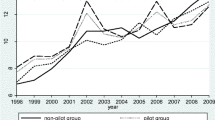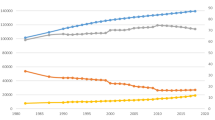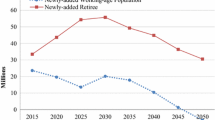Abstract
Employing an endogenous growth model with human capital, this paper investigates China’s partially funded public pension system. We examine the effects of the firm’s contribution rate and individual’s contribution rate on the per capita income growth rate, population growth rate, saving rate, education expense ratio and net wealth transfer ratio. Raising the firm’s contribution rate increases the per capita income growth rate, saving rate, net wealth transfer ratio and education expense ratio, whereas it decreases the population growth rate. Raising the individual’s contribution rate decreases the per capita income growth rate, saving rate and education expense ratio, whereas it increases the population growth rate, but has no effect on the net wealth transfer ratio. Integrating the important essential policies and the current economic goals of China and balancing the large difference between the effects of the two contribution rates on the endogenous variables raising the individual’s contribution rate by a large margin and the firm’s contribution rate by a little has more advantages than disadvantages. The real contribution rates can be raised as long as the government verifies the number of employees and payroll in practice.
Similar content being viewed by others
References
Kotlikoff L, Summers L. The role of intergenerational transfers in aggregate transfers. Journal of Political Economy, 1981, 90: 706–732
Zhang J S, Zhang J X. The effects of social security on population and output growth. Southern Economic Journal, 1995, 62(2): 440–450
Zhang J S, Zhang J X. Social security, intergenerational transfers, and endogenous growth. Canadian Journal of Economics. Revue Canadienne d’Economique, 1998, 31(5): 1225–1241
Wigger B U. Pay-as-you-go financed public pensions in a model of endogenous growth and fertility. Journal of Population Economics, 1999, 12(4): 625–640
Zhang J. Social security and endogenous growth. Journal of Public Economics, 1995, 58(2): 185–213
Zhang J. Long-run implications of social security taxation for growth and fertility. Southern Economic Journal, 2001, 67(3): 713–724
Zhang J S, Zhang J, Lee R. Mortality decline and long-run economic growth. Journal of Public Economics, 2001, 80(3): 485–507
Pecchenino R A, Pollard P S. Dependent children and aged parents: funding education and social security in an aging economy. Journal of Macroeconomics, 2002, 24(2): 145–169
The Chinese State Council. Decision on Establishing a Unified Basic Pension System for Enterprise Employees (State Council Document 26 in 1997). 1997, http://trs.molss.gov.cn/was40/detail?record = 139&channelid = 8457
The Chinese State Council. Decision on Improving the Basic Pension System for Enterprise Employees (State Council Document 38 in 2005). 2005, http://trs.molss.gov.cn/was40/detail?record = 1&channelid = 8457
Barro R, Sala-i-Martin X. Economic Growth, 2nd ed. Cambridge: MIT Press, 2004
Yew S, Zhang J. Optimal social security in a dynastic model with human capital externalities, fertility and endogenous growth. Journal of Public Economics, 2009, 93(3–4): 605–619
Feldstein M. Banking, budgets, and pensions: some priorities for Chinese policy, 2003, http://www.nber.org/feldstein/chinaforum5.pdf
Author information
Authors and Affiliations
Corresponding author
Rights and permissions
About this article
Cite this article
Yang, Z. Partially funded public pension, human capital and endogenous growth. Front. Comput. Sci. China 4, 271–279 (2010). https://doi.org/10.1007/s11704-010-0510-8
Received:
Accepted:
Published:
Issue Date:
DOI: https://doi.org/10.1007/s11704-010-0510-8




